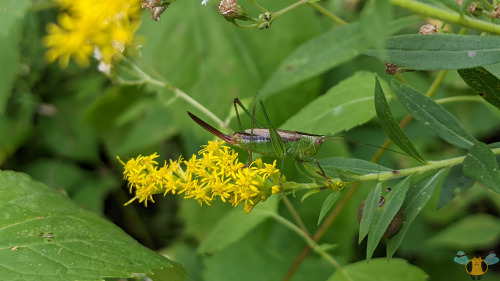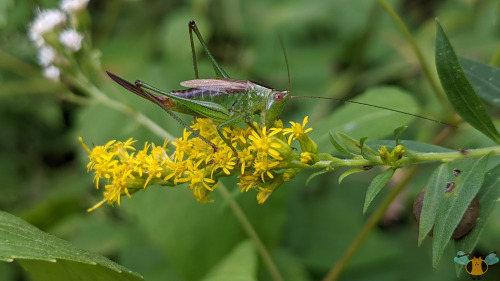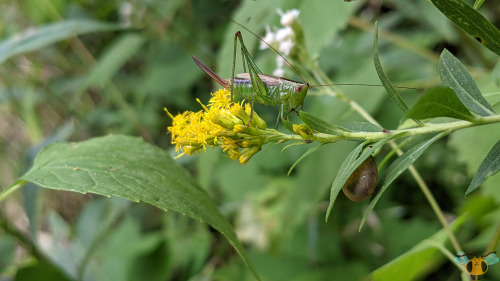#short winged meadow katydid
Short-Winged Meadow Katydid - Conocephalus brevipennis
With my field guides and my main literature resource explored, this blog returns to the showcase of many beautiful and wonderful insects of Ontario (and beyond)! This insect is actually one of the few insects that isn’t included in the current Audubon field guide, so lets revisit it today. True to her name, she has shortened wings across her back. This is how they’re commonly seen, but you might be able to find one with elongated wings if you’re lucky! With a blade on her abdomen, she’s definitely a female specimen. She was observed crawling on a goldenrod stem that’s gently drooping down due to the weight of the Katydid (and maybe the snail hiding underneath the leaves?). Looks like she was searching among the flowers for a tasty snack. While the flowers didn’t get more than a nibble, there are pieces of leaf in between her mandibles in some images, and in some other images are her legs which she cleans every so often as she travels. It’s amazing just how simple yet sophisticated an Orthopteran’s mouthparts are: delicate enough to clean without scraping the legs, but powerful enough to tear plants and soft-bodied insects for nourishment. The mandibles are the prominent insect mouthpart given that they do most of the chewing, but let’s highlight some other important mouthparts.
Let’s get started with insect lips (really). They aren’t lips as we know them, but they act as supports to keep any food in their grasp contained while they shovel it in. They are known as the labrum (front lip) and the labium(back lip), acting more like plates and graspers. With the food stable, flexible structures that hang down from mouth called palps,and set of secondary jaws calledmaxilla(maxillae plural). The latter are used to orient the food around while its being chewed. They come in handy for pushing food into the mandibles and navigating a captured insect in search of a soft spot (this Katydid may not appreciate the later since they tend to be opportunistic rather than hunters). The palps on the other hand are used to sense, assess and “taste” the food. They don’t necessary function as primary tongues, but they are essential for the insect to interpret the world around it. The Larger palps in the front are called maxillary palps while a set of smaller palps on the back lip are called (you guessed it) labial palps. All these parts work together harmoniously to keep this Katydid well fed as she explores the forest, while carnivorous insects would use these same mouthparts as powerful weapons to hunt. They certainly are effective either way, but there are other alterations to those mouthparts that help other insects thrive. Mosquitoes for example, they don’t use mandibles to tear up food. What other insects can you think of? Check the guides if you need to.
Pictures were taken on September 11, 2021 in Kleinburg with a Google Pixel 4.
Post link










